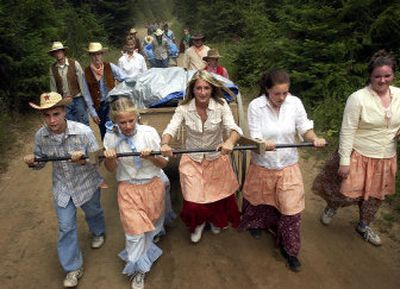Mormons re-create trek

After helping to push a handcart loaded with 170 pounds of gear through the forest between Spirit Lake and Twin Lakes, Fawn Carey and Cheryl Ulrich got right to work preparing stew.
Wearing floor-length dresses like the pioneers wore, Carey, 18, and Ulrich, 17, both members of the Spokane Valley Stake of the Church of Jesus Christ of Latter-day Saints, kneeled on the ground Friday, using a stump as a cutting board for potatoes and carrots.
“It’s tough. Especially wearing a dress,” said Carey.
The teens were part of a group of about 200 youths from their church reenacting their faith ancestors’ migration to the West.
It signifies what is known as the great migration, when 70,000 Mormons traveled to the Salt Lake valley from Illinois in the 1800s, according to church historians. Most traveled on horses and wagons, but the poorest of the faithful walked, pulling their possession in handcarts.
It was this group that the Spokane Valley members chose to follow.
The teens assembled into “families” of 10 and took the actual family names from the groups led by James Willie and Edward Martin, British converts who led handcart companies to Salt Lake in 1856. About 200 people from the Willie-Martin handcart companies died while walking to Utah, when an early snowfall hit Wyoming’s high plains.
On Friday, the Spokane Valley “companies” walked 12 miles to camp at the west end of Twin Lakes. On Saturday, they will walk 13 more, pushing the handcarts halfway up Mt. Spokane.
“We are a very faithful people and we truly believe in our religion” said Jenna Lake, a parent volunteer. “There was a great deal of sacrifice to bring that to where we are today. It tells a story of heroism, valor, determination and faith.”
Lake’s father, Ted Demars, joined a wagon train along the actual migration trail to Salt Lake in 1997 to commemorate the 150th anniversary of the journey. He brought his wagon for this weekend’s journey, driven by two of his mules from his ranch near Stateline, Idaho.
Although the distance walked by the teens was short compared to original 1,300-mile journey, “it’s important for them to know what their ancestors went through,” Demars said.
Still, glimpses of 2005 could not be avoided – like the bag of charcoal briquettes bought from Wal-Mart to make dinner a little easier, and the row of port-a-potties lining the road.
As the last group of teens wandered into camp, some flopped onto the ground, too exhausted to move.
Others, like Ulrich and Carey, got busy with preparations.
“I’ve got blisters on my feet,” said Spencer Ekenes, 18, while gathering wood for a fire.
Unfortunately for Ekenes, traditional square-dancing was planned after dinner.
“It’s a great experience, especially for the teenagers. It can be a time of introspection,” Lake said. “A lot of figuring out who you are is knowing where you came from.”